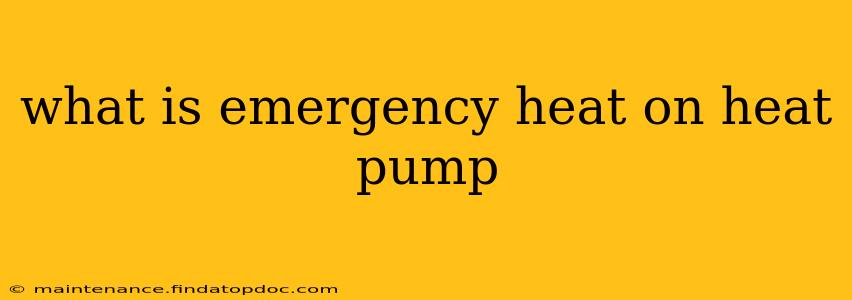Heat pumps are increasingly popular for their energy efficiency, but understanding how they work—especially their backup systems—is crucial for comfort during cold snaps. This guide will explain what "emergency heat" is on a heat pump, how it works, and when you might need it.
What Does Emergency Heat Do?
Emergency heat, also sometimes called "electric backup heat," is a supplementary heating system built into most heat pumps. It's a crucial safety net designed to kick in when the heat pump alone can't keep your home warm enough, particularly during extremely frigid temperatures. Unlike the heat pump's efficient heat exchange process, emergency heat uses electric resistance heating, similar to the heating elements in a standard electric space heater.
How Does Emergency Heat Work?
A heat pump works by extracting heat from the outside air (even in cold weather, there's still some heat) and transferring it inside. However, below a certain temperature (this varies by model), the heat pump becomes less efficient and may struggle to produce enough heat. This is where emergency heat comes into play. When the heat pump senses it can't maintain the set temperature, it automatically switches to the electric resistance heating elements. These elements directly convert electricity into heat, providing a quick and powerful, albeit less efficient, boost of warmth.
Is Emergency Heat Expensive to Run?
Yes, emergency heat is significantly more expensive to operate than the heat pump's normal heating mode. Electric resistance heating is far less efficient than the heat-exchange process of a heat pump. You'll likely see a substantial jump in your energy bill if your system relies heavily on emergency heat. This is why it's crucial to ensure your heat pump is properly sized and maintained for your climate.
Why is Emergency Heat More Expensive?
Electric resistance heating essentially converts 100% of the electricity it consumes into heat. While this is straightforward, it's not energy-efficient. Heat pumps, on the other hand, move heat; they don't generate it directly from electricity. They can move a significant amount of heat using a much smaller amount of electricity, resulting in much lower operating costs.
When Should I Use Emergency Heat?
Ideally, you should rarely, if ever, need to use emergency heat. Your heat pump should be able to maintain your desired temperature under most conditions. However, extremely cold temperatures, improperly sized heat pumps, or necessary repairs may necessitate using emergency heat.
How Do I Know If My Heat Pump is Using Emergency Heat?
Your thermostat will usually indicate when the emergency heat is engaged, often by displaying a distinct symbol or message like "Electric Heat," "Emergency Heat," or "Backup Heat." You may also notice a significant increase in the sound of your heating system—the electric resistance elements often produce a noticeable humming or buzzing sound.
How Can I Minimize Emergency Heat Usage?
- Proper Heat Pump Sizing: Ensure your heat pump is appropriately sized for your home's square footage and insulation levels. A professional HVAC technician can help determine the correct size.
- Regular Maintenance: Schedule annual maintenance checks to ensure your heat pump is operating efficiently and identify any potential problems before they become major issues. This includes checking refrigerant levels and cleaning components.
- Improve Home Insulation: Boosting your home's insulation can significantly reduce heat loss and minimize the need for supplemental heating.
- Use a Programmable Thermostat: A programmable thermostat can help optimize your heating schedule and reduce energy consumption.
Is it Bad to Use Emergency Heat Frequently?
While infrequent use is fine, consistent reliance on emergency heat is a sign that something might be wrong with your heat pump's operation. This increased reliance signals higher energy costs and potential problems requiring professional attention.
By understanding how emergency heat functions within your heat pump system, you can better manage energy consumption and ensure your home remains comfortable throughout the year. Remember, preventative maintenance and proper sizing are key to minimizing reliance on this less-efficient heating mode.
